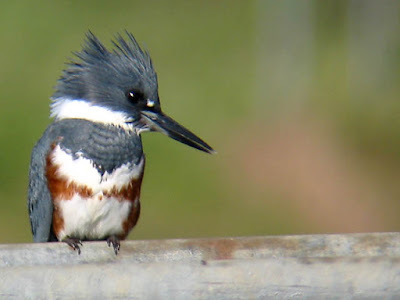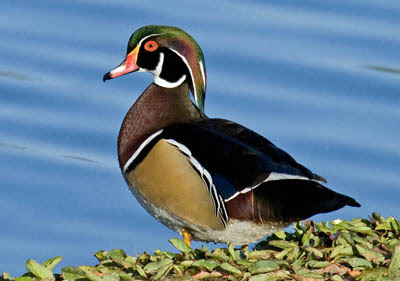Last Updated on January 25, 2024 by Greg Gillson
Have you noticed a bird with a crest, tuft, or mohawk on its head? Did you wonder what it was and think that it should be easy to figure out? Not so!
A surprising number of birds from many different groups have crests.
You may know some crested birds from your backyard, like Northern Cardinals, Blue Jays, and Tufted Titmice in the East.
Likewise, Steller’s Jays, Oak Titmice, and Juniper Titmice are backyard birds with crests in the West.
But then there are widespread Cedar Waxwings, Pileated Woodpeckers, and Great Crested Flycatchers.
And don’t forget about Wood Ducks, Ruffed Grouse, Eared Grebes, Black-crowned Night-Herons, and Belted Kingfishers.
Here is an incomplete list of crested birds in the US. Plus, I list some birds with crests from elsewhere in the world that come to mind.
 |
| Belted Kingfisher. Greg Gillson. |
What is a crest on a bird?
A crest is simply a group of longer feathers growing from the crown on a bird.
These are modified contour feathers. There is nothing otherwise special about them.
If the crown feathers on a bird are all rather short, then the head shape appears rounded, following the contour of the skull.
Certain birds have slightly longer crown feathers, forming a peak at the back of the head. Flycatchers are an example. These normally aren’t considered a crest if the individual feathers blend smoothly. A ragged partial crest may be formed as individual feathers break from the hind-head contour.
If the longer crown feathers stick up at all times, then it is considered a crest.
Crests composed of fewer crown feathers may be labeled as tufts.
Some birds have long feathers of the side of the head during breeding season, like the Eared Grebe.
The crests on some species of terns are off the hind neck.
I had pelicans on this list for a while. In the breeding season they have long feathers on their hind crown and back of neck like a mane on a horse.
Most (all?) birds have the ability to raise their crown feathers. Thus, even the male round-headed Ruby-crowned Kinglet can raise his green crown feathers. Then a normally hidden fiery red crown patch is revealed, as the red bases of the crown feathers are exposed. [See below]. This is not usually considered to be a crest–just raised crown feathers (but a similar bird in Europe and Africa is called a Firecrest).
 |
| Raised crown feathers of Ruby-crowned Kinglet. Greg Gillson. |
Following is an incomplete list of crested birds in North America. I have included a few photos as examples.
Tufted Duck
Wood Duck
 |
| Wood Duck. Greg Gillson. |
Hooded Merganser
Red-breasted Merganser
 |
| Red-breasted Merganser. Greg Gillson. |
Ruffed Grouse
Scaled Quail
Eared Grebe
 |
| Eared Grebe. Greg Gillson |
Crested Caracara
Osprey
Tufted Puffin
Double-crested Cormorant
Greater Roadrunner
 |
| Greater Roadrunner. Greg Gillson |
Elegant Tern
Belted Kingfisher
Pileated Woodpecker
 |
| Pileated Woodpecker. Greg Gillson |
Great Crested Flycatcher
Brown-crested Flycatcher
Ash-throated Flycatcher
 |
| Ash-throated Flycatcher. Greg Gillson |
Tufted Flycatcher
Blue Jay
Steller’s Jay
 |
| Steller’s Jay. Greg Gillson |
Tufted Titmouse
Oak Titmouse
Black-crested Titmouse
Juniper Titmouse
Bridled Titmouse
 |
| Bridled Titmouse. Greg Gillson |
Bohemian Waxwing
Phainopepla
Cedar Waxwing
 |
| Cedar Waxwing. Greg Gillson |
Northern Cardinal
Pyrrhuloxia
 |
| Pyrrhuloxia. Greg Gillson |
Some birds with crests outside the United States:
Great Crested Grebe
Crested Tern
Peacock
Black-crested Magpie-Jay
Victoria Crowned Pigeon
Harpy Eagle
Lapwing
Antillean Crested Hummingbird
Rufous-crested Coquette
Green-crowned Plovercrest
Cockatoo
Cockatiel
Secretary Bird
Wrapping Up
Birds raise the feathers on their heads into crests for various reasons, depending on the specific species and situation. Here are some common reasons:
Communication:
- Displaying dominance: In many species, a raised crest signals dominance or aggression, warning rivals to stay away or establishing themselves as the higher-ranking individual. This is often accompanied by other body language like puffed-up chest feathers and raised wings.
- Attracting mates: For some birds, a raised crest is part of an elaborate courtship display to impress potential mates. The increased size and visibility of the crest can showcase their health, fitness, and suitability as a partner.
- Maintaining awareness: In some cases, a raised crest simply helps improve their field of vision, offering a wider view of their surroundings for better vigilance and predator detection.
Temperature regulation:
- Trapping air: In cold weather, raising the crest can create a small air pocket that helps insulate the head and retain body heat.
- Dispersing heat: In warmer weather, raising the crest can increase air circulation around the head, aiding in heat dissipation.
Camouflage:
- Breaking up outline: Raising the crest can disrupt the bird’s overall shape, making it less conspicuous to predators while camouflaged amongst foliage or other natural settings.
Frequently Asked Questions
What are the small birds with tuft on their head?
Tufted Titmice, with their distinctive brushy crests, raise and lower them for several reasons, primarily related to communication and social interaction:
1. Territory and Dominance:
- A raised crest often communicates dominance or aggression towards rivals. It warns competing Titmice to stay away from their territory or food source. The crest serves as a visual signal, making the bird appear larger and more intimidating.
2. Communication and Social Interaction:
- Titmice also raise their crests during social interactions with other Titmice. This could be a greeting gesture, a way to convey excitement or curiosity, or even a signal of submission. The exact meaning depends on the context and other body language cues.
3. Threat Detection and Defense:
- Raising the crest can improve a Titmouse’s field of vision, allowing them to scan their surroundings for potential threats more effectively. This increased awareness aids in predator detection and escape strategies.

Which birds has bony crest on its head?
The peculiar structure on top of a Southern Cassowary is called a casque. It’s not quite a crest like some birds have, but rather a hard, helmet-like protrusion made up of keratin (the same material as our fingernails). The exact purpose of the casque is still a bit of a mystery, but there are several interesting theories:
Protection:
- Helmet: The thick, sturdy casque might act as a helmet, protecting the skull from blows during fights with other cassowaries or potential predators.
- Shock absorber: Its spongy interior could help absorb impacts, cushioning the head during rough interactions or when pushing through dense vegetation.

What kind of bird has a crown on its head?
You might be talking about the Hoopoe. That distinctive feature on top of its head is called a crest. It’s composed of elongated feathers that can be raised and lowered at will. This crest plays several important roles for the hoopoe:
- Displaying dominance or aggression: When raised, the crest makes the hoopoe appear larger and more intimidating, warning rivals to stay away from its territory or food sources.
- Attracting mates: During courtship displays, males raise their crests to impress potential partners, showcasing their health and fitness.
- Maintaining awareness: In some cases, a raised crest simply helps improve the hoopoe’s field of vision, offering a wider view of its surroundings for better vigilance and predator detection.

Related Articles:
Why so weird? Do bird’s knees really bend backwards?






